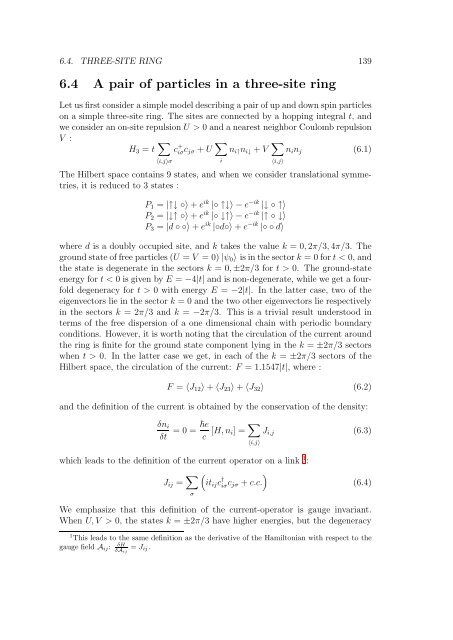pdf, 9 MiB - Infoscience - EPFL
pdf, 9 MiB - Infoscience - EPFL
pdf, 9 MiB - Infoscience - EPFL
You also want an ePaper? Increase the reach of your titles
YUMPU automatically turns print PDFs into web optimized ePapers that Google loves.
6.4. THREE-SITE RING 139<br />
6.4 A pair of particles in a three-site ring<br />
Let us first consider a simple model describing a pair of up and down spin particles<br />
on a simple three-site ring. The sites are connected by a hopping integral t, and<br />
we consider an on-site repulsion U>0 and a nearest neighbor Coulomb repulsion<br />
V :<br />
H 3 = t ∑<br />
n i↑ n i↓ + V ∑ n i n j (6.1)<br />
〈i,j〉<br />
c + iσ c jσ + U ∑<br />
〈i,j〉σ i<br />
The Hilbert space contains 9 states, and when we consider translational symmetries,<br />
it is reduced to 3 states :<br />
P 1 = |↑↓ ◦〉 + e ik |◦ ↑↓〉 − e −ik |↓ ◦ ↑〉<br />
P 2 = |↓↑ ◦〉 + e ik |◦ ↓↑〉 − e −ik |↑ ◦ ↓〉<br />
P 3 = |d ◦◦〉+ e ik |◦d◦〉 + e −ik |◦ ◦ d〉<br />
where d is a doubly occupied site, and k takes the value k =0, 2π/3, 4π/3. The<br />
ground state of free particles (U = V =0)|ψ 0 〉 is in the sector k =0fort0. The ground-state<br />
energy for t0withenergyE = −2|t|. In the latter case, two of the<br />
eigenvectors lie in the sector k = 0 and the two other eigenvectors lie respectively<br />
in the sectors k =2π/3 andk = −2π/3. This is a trivial result understood in<br />
terms of the free dispersion of a one dimensional chain with periodic boundary<br />
conditions. However, it is worth noting that the circulation of the current around<br />
the ring is finite for the ground state component lying in the k = ±2π/3 sectors<br />
when t>0. In the latter case we get, in each of the k = ±2π/3 sectors of the<br />
Hilbert space, the circulation of the current: F =1.1547|t|, where:<br />
F = 〈J 12 〉 + 〈J 23 〉 + 〈J 32 〉 (6.2)<br />
and the definition of the current is obtained by the conservation of the density:<br />
δn i<br />
δt =0=e c [H, n i]= ∑ J i,j (6.3)<br />
〈i,j〉<br />
which leads to the definition of the current operator on a link 1 :<br />
J ij = ∑ (<br />
)<br />
it ij c † iσ c jσ + c.c.<br />
σ<br />
(6.4)<br />
We emphasize that this definition of the current-operator is gauge invariant.<br />
When U, V > 0, the states k = ±2π/3 have higher energies, but the degeneracy<br />
1 This leads to the same definition as the derivative of the Hamiltonian with respect to the<br />
δH<br />
gauge field A ij :<br />
δA ij<br />
= J ij .
















